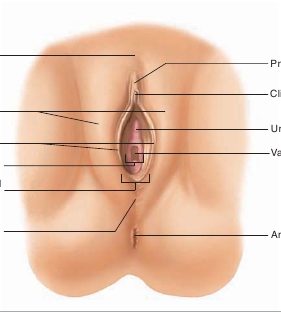1054
PART 5 Reproduction and Development

Columnar epithelial cells line the cervical canal, which contains
cervical mucous glands.
The mucus fills the cervical canal and actsas a barrier to substances that could pass from the vagina into theuterus. Near ovulation, the consistency of the mucus changes, easingthe passage of sperm cells from the vagina into the uterus.

ASSESS
YOUR PROGRESS
48.
Describe the structure of the uterine tube.
49.
How are the uterine tubes involved in moving the oocyteor the zygote?
50.
Name the parts of the uterus.
51.
Describe the major ligaments holding the uterus in place.
52.
Describe the layers of the uterine wall.
Monspubis
Prepuce
Clitoris
Labiamajora
LabiaminoraVestibule
Pudendalcleft
Clinicalperineum
Urethra
Vagina
Anus
Vagina
The
vagina
(v ă -j ī ′n ă ) is the female organ of copulation, receiving thepenis during intercourse. It also allows menstrual flow and child-birth. The vagina is a tube about 10 cm long that extends from theuterus to the outside of the body (see figure 28.12). Longitudinalridges called
columns
extend the length of the anterior and posteriorvaginal walls, and several transverse ridges called
rugae
(roo′g ē )extend between the anterior and posterior columns. The superior,domed part of the vagina, the
fornix
(f ō r′niks), is attached to thesides of the cervix, so that a part of the cervix extends into the vagina.The wall of the vagina consists of an outer muscular layer andan inner mucous membrane. The muscular layer is smooth musclethat allows the vagina to increase in size to accommodate the penisduring intercourse and to stretch greatly during childbirth. Themucous membrane is moist stratified squamous epithelium thatforms a protective surface layer. The vaginal mucous membranereleases most of the lubricating secretions produced by the femaleduring intercourse.The
hymen
(h ī ′men) is a thin mucous membrane that coversthe
vaginal opening,
or
orifice.
Sometimes, the hymen completelycloses the vaginal opening (a condition called imperforate hymen),and it must be removed to allow menstrual flow. More commonly,the hymen is perforated by one or several holes. The openings inthe hymen are usually greatly enlarged during the first sexual inter-course. In addition, the hymen can be perforated earlier in a youngwoman’s life, such as during strenuous physical exercise. Thus, theabsence of an intact hymen does not necessarily indicate that awoman has had sexual intercourse, as was once thought.

ASSESS
YOUR PROGRESS
53.
What are the functions of the vagina?
54.
Describe the layers of the vaginal wall. What are rugaeand columns?
55.
What is the hymen?
FIGURE 28.15
Female External Genitalia
External Genitalia
The external female genitalia is the
vulva
(v ŭ l′v ă ), or
pudendum
(p ū -den′d ŭ m). It consists of the vestibule and its surroundingstructures (figure 28.15). The
vestibule
(ves′ti-bool) is the space
into which the vagina opens posteriorly and the urethra opensanteriorly. A pair of thin, longitudinal skin folds called the
labia
(l ā ′b ē - ă ; lips)
minora
(sing. labium minus) form a border on eachside of the vestibule. A small, erectile structure called the
clitoris
(klit′ ō -ris) is located in the anterior margin of the vestibule. Anteri-orly, the two labia minora unite over the clitoris to form a fold ofskin called the
prepuce.
The clitoris is usually less than 2 cm in length and consists ofa shaft and a distal glans. Well supplied with sensory receptors, itinitiates and intensifies levels of sexual sensation. The clitoriscontains two erectile structures, the
corpora cavernosa,
each ofwhich expands at the base end of the clitoris to form the
crus ofthe clitoris
and attaches the clitoris to the pelvic bones. The cor-pora cavernosa of the clitoris are comparable to the corpora cav-ernosa of the penis, and they become engorged with blood as aresult of sexual excitement. In most women, this engorgementresults in an increase in the diameter, but not the length, of theclitoris. With increased diameter, the clitoris makes better contactwith the prepuce and surrounding tissues and is more easilystimulated.Erectile tissue that corresponds to the corpus spongiosum ofthe male lies deep to and on the lateral margins of the vestibularfloor on each side of the vaginal orifice. Each erectile body iscalled a
bulb of the vestibule.
Like other erectile tissue, itbecomes engorged with blood and is more sensitive during sexualarousal. Expansion of the bulbs causes narrowing of the vaginalorifice and allows better contact of the vagina with the penis duringintercourse.Glands associated with the vestibule secrete a lubricating fluidthat prevents drying of the vestibule. The ducts of the greater ves-tibular glands open on each side of the vestibule, between the vagi-nal opening and the labia minora. Additional small mucous glands,the
lesser vestibular glands,
or
paraurethral glands,
are locatednear the clitoris and urethral opening.